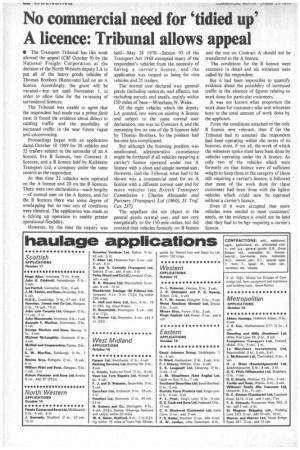No commercial need for 'tidied up' A licence: Tribunal allows appeal
Page 34

If you've noticed an error in this article please click here to report it so we can fix it.
• The Transport Tribunal has this week allowed the appeal (CM October 9) by the National Freight Corporation at the decision of the North Western deputy. LA to put all of the heavy goods vehicles of Thomas Brothers (Removals) Ltd on an A licence. Accordingly, the grant will be vacated—but not until November 1, in order to allow time for the re-issuing of surrendered licences.
The Tribunal was unable to agree that the respondent had made out a prima facie case. It found the evidence about delays to existing traffic and the possibility of increased traffic in the near future vague and unconvincing.
Proceedings began with an application dated October 18 1969 for 38 vehicles and 25 trailers subject to the surrender of an A licence, five B licences, two Contract A licences, and a B licence held by Kathleens Transport Ltd, a company under the same control as the respondent.
At that time 22 vehicles were operated on the A licence and 20 on the B licences. There were two declaration s--each lengthy —of normal user on the A licence, and for the B licences there was some degree of overlapping but no two sets of conditions were identical. The application was made as a tidying up operation to enable greater .operational flexibility.
However, by the time the inquiry was held—May 28 1970—Section 93 of the Transport Act 1968 exempted many of the respondent's vehicles from the necessity of having a carrier's licence, and the application was treated as being for nine vehicles and 25 trailers.
The normal user declared was general goods (including removals and effects), but excluding parcels and smalls, mainly within 150 miles of base—Wrexham, N. Wales.
Of the eight vehicles which the deputy LA granted, two were on existing A licence and subject to the same normal user declaration, one was on Contract A and the remaining five on one of the B licences held by Thomas Brothers. So the position had become less complicated.
But although the licensing position was ameliorated, administrative convenience might be furthered if all vehicles requiring a carrier's licence operated under one A licence with a short and simple normal user. However, said the Tribunal, what had to be shown was a commercial need for an A licence with a different normal user and for more vehicles (see British Transport Commission v Charles Alexander and Partners (Transport) Ltd (1960), 31 Traf Cas. 237).
The appellant did not object to the general goods normal user, and not very energetically to the 150-mile radius, but did contend that vehicles formerly on B licence and the one on Contract A should not be transferred to the A licence.
The conditions for the B licence were extensive in detail and six witnesses were called by the respondent.
But it had been impossible to quantify evidence about the possibility of increased traffic in the absence of figures relating to work done for particular customers.
It was not known what proportion the work done for customers who sent witnesses bore to the total amount of work done by the applicant.
From the conditions attached to the only B licence now relevant, then if (as the Tribunal had to assume) the respondent had been operating within the terms of its licences, most, if not all, the work of which the witnesses spoke must have been done by vehicles operating under the A licence. As only two of the vehicles which were formerly on that licence were of sufficient weight to keep them in the category of those still requiring a carrier's licence, it followed that most of the work done for these customers had been done with the lighter vehicles which could now be, operated without a carrier's licence.
Even if it were accepted that more vehicles were needed to meet customers' needs, on the evidence it could not be held that they had to be hgv requiring a carrier's licence.






































































































